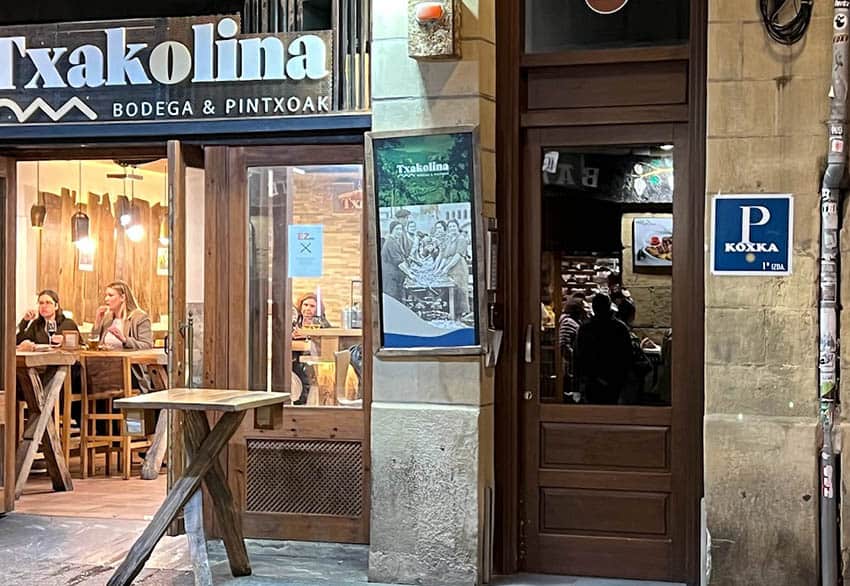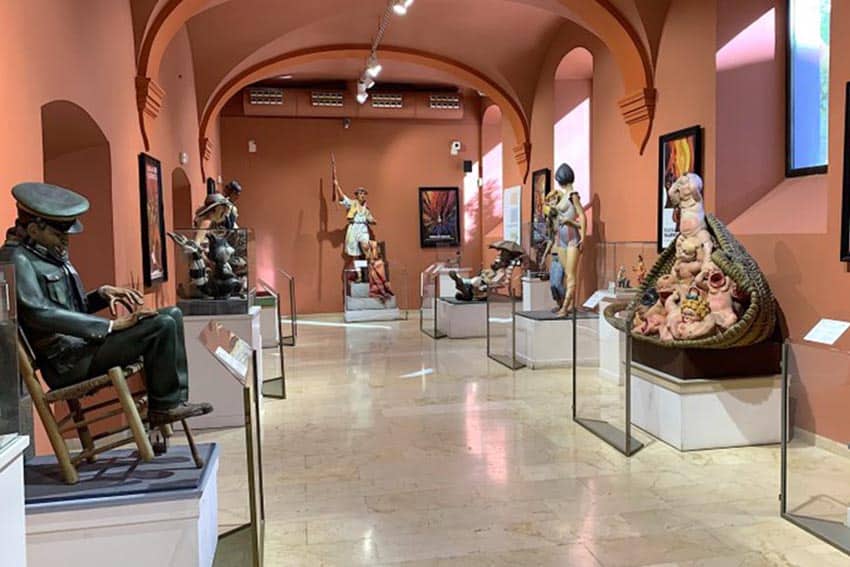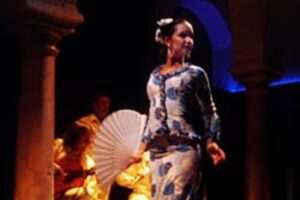
San Telmo Museoa, with Pintxos and Cheesecake San Sebastian, Spain

By Susan Kraus
It was a rainy Tuesday morning in October when I walked into the San Telmo Museoa in Donostia-San Sebastian, Spain. I’d been in the city for a week at that point, my first visit to northern Spain and the Basque region.
I was staying in a small rock-walled room in Pension Koxka, ideally situated on a historic street, 31 de Agosto, in the heart of the cobblestoned Old Town.
I was told that on August 31, 1813, the city was consumed by fire after military bombardments during the Napoleonic Wars. The only remaining street was the one that connected the two oldest churches: San Vincente and Santa Maria. Hence the name.
It continues to be a vibrant street. My room was directly over a café and bar (yet totally soundproof) and directly across from La Viña, one of the most famous pinxtos (pronounced ‘peen-chus’) bars in the city. The San Telmo Museoa was just steps from my pension.
The San Telmo Museoa:
On entering the chapel of the 16th century Dominican monastery that is the heart of the San Telmo Museoa, I was gob-smacked by the giant monochromatic canvasses that cover every wall.
They depict the lives of the Basque people, their challenges and triumphs, including merchants, ship-builders, fisherman, farmers, herders and more. But why did they feel familiar?
It took a few days for me to connect-the-dots to the lobby of Rockefeller Center In New York City! The artist, Josep M. Sert, was commissioned in 1937 by the Rockefeller family to create a massive (16’ by 41’) mural for their ‘new’ building. (An international mural controversy, interfacing art and politics, preceded his commission.)
As a kid, I walked through that lobby many times, looking up at art that seemed to be in motion. Now, at 73, I was again swept up by its power.
Everything Basque:
The San Telmo Museoa isn’t just art or history or culture, but everything Basque: the evolution of Basque heritage, as well as the expression and expansion of that heritage in current life.
Many museums show, and tell, the stories of the past through art and artifacts, illustrations and writing.
The goal of San Telmo Museoa is somewhat different: to show the past in order to better understand, continue and expand upon Basque culture.

Overview:

The museum is two distinct structures, one a 16th century monastery and the other contemporary, designed to enclose the remaining monastery and house the museum.
The monastery was dedicated to San Telmo (Saint Elmo). the patron saint of sailors.
Screens throughout the chapel and museum illustrate the stages and meticulous process of the artists, in video form, with four language options: Euskara, Castellano, French and English.
When showing interviews, there are subtitles with your language selection.
Euskara:
Euskara, the native language of the Basque people, is essential to preserving Basque heritage. Euskara has a linguistic structure different from most other languages, and is thus labeled an ‘isolate.’
I was embarrassed that I’d never heard of it, while intrigued to learn more as its origins and evolution are still the subject of linguistic research and debate.
The real mystery of Euskara is how it has survived, over centuries, despite occupations and repression, and how it continues, still spoken in daily life.
Museum Exhibits Overview:
Basque rituals of grief and death go back centuries, and the artifacts of religious practices are presented and explained, from argizaiola (funeral candles) to steles (small stone monuments that mark graves, with samples from pre-Roman to late 19th century.)
The purpose of each artifact and practice, like how bodies were never left alone until the funeral, are explained, as each had a role in ‘shepherding’ the deceased into the next life.

The Memory Traces exhibits explore human origins in the region (dating back 150,000 years); the evolution of farming; Roman occupation; feudal society; the town ‘brotherhoods’ that led to the overthrow of feudal lords; iron and the development of forges; the impact of corn; whaling; shipbuilding; the interface of Christianity and pagan/cultural practices; the impact of the Jesuit order; and more. It’s a lot to absorb.
Living in Society exhibits track the Industrial Revolution and its impact on social, political, and cultural daily life, the Carlist Wars, railroad development, conflicting ideologies, the Spanish Civil War, and the repressive dictatorship of Franco.
The overall unifying theme is how each generation coped and how traditions were maintained. Art, from historical and religious to contemporary and avant-garde, is integrated into exhibits.

Take Your Time:
I intended to do a quick walk through the San Telmo Museoa, but ended up spending a half-day and then returning another day. I wanted to watch and listen to every audio-visual in every exhibit.
Overall, this is a museum that looks forward as much as it looks back: a critical role is to promote dialogue and debate of current issues, including peace, human rights, sustainability, gender equity, and the power of individuals to initiate change.
There is a lovely restaurant in the museum that specializes in Basque cuisine. If you can take a day, plan on a leisurely lunch and ask the staff for recommendations.
A Few Words About Donostia-San Sebastian:
Donostia-San Sebastian perches on the Bay of Biscay, a small corner of the Atlantic, at the point where Spain meets France and the Iberian Peninsula begins. Donostia is the Euskara name, San Sebastian the Spanish.

It was a city of fisherman and shipbuilders, ironworkers, farmers and shepherds. But its location, natural beauty and beaches pushed it into popularity as a resort for the European upper-class. British royalty came to San Sebastian for the ‘waters.’

It was one of the first cities to host car racing, and Belle Époque grand hotels circled the beaches. There is a six-kilometer seafront promenade, a French 19th century garden, three mountains —one with a funicular and retro amusement park, one a cemetery that feels romantic, one with cliffs over the sea, all with stellar views— all within the city. It’s also a top vacation destination for Europeans.
A Few Words About the Eglises (Basque for church):
San Vicente is adjacent to the San Telmo, while the Eglise de Santa Maria is close to the bay and beach. The Eglise de Santa Maria is quite grand, with multiple small alters and magnificent statuary and art.
It really should be a cathedral, but there is apparently a liturgical rule that a cathedral must have a front door that faces directly to the main altar, and here the entrance is on one side. So, it’s a basilica, one step down from the cathedral designation.
There is also a museum incorporated into the church, definitely worth a visit. Take the back stone staircase to the top floor for more.
Eglise San Vincente is less of an ‘attraction’ and more local church. I was in San Sebastian for All Souls’ Day, and slipped into the back of the church during Mass.
The Mass was in Basque, the choir chanting in Latin and Basque. Their voices resonated off the stone walls, filling this sacred space as they have for centuries.
For the Love of Pintxos:

Pronounced ‘Peen-chus,’ pintxos are the Basque version of tapas. Old Town’s pedestrian-only streets are lined with restaurants, cafes and small shops.
But, unlike Barcelona, and many other Old Towns, it is not a labyrinth, but squared streets, easy to navigate, a vibrant center of ‘pintxos traditions’: stop in one café, have a glass of wine (Crianza was my favorite) and a pintxos, then stroll down the street and do it again… and again… and again.
Pintxos are hand-held (ask for a fork for the hot versions), and eaten standing at a bar or outside a bar or crowded around tables in a bar. Bars are lined with ‘displays’ behind glass so you can choose.
Some cafes assign each pintxos a number, so one hands a server a list of the numbers you want without having to remember (or know) what that particular pintxos is called. Just observe the other customers for five minutes and you’ll figure it out.
The Absolute Best Cheesecake on the Planet:
This has nothing to do with the rest of the article, but if anyone were to go to San Sebastian and not had the satisfaction of tasting the Basque Burnt Cheesecake at La Viña (adjacent to Iglise San Vincente on 31 de Agosto), I would feel negligent. La Viña, a family establishment since 1959, is one of the most popular and reasonably priced pintxos bars in the city. It also has an upscale restaurant on site.
 But what people return for is to savor the melting lusciousness of their Burnt Basque Cheesecake. A $6 hefty slice must be eaten immediately, still warm, never refrigerated (I made that mistake).
But what people return for is to savor the melting lusciousness of their Burnt Basque Cheesecake. A $6 hefty slice must be eaten immediately, still warm, never refrigerated (I made that mistake).
I’ve added a link to a TV segment on La Viña. I watched from my pension as people lined up to get their cheesecake, then stood in the street smiling as they ate. My last night in San Sebastian, I ran downstairs in my PJs to get one last slice before closing.
In Sum:
Donostia-San Sebastian is a city with cosmopolitan, international flare and flavor, yet compact in size. I walked for hours along the beachfront, through neighborhoods, and up steep trails.
This small city has more Michelin starred restaurants per capita than any other city in Europe (11 stars total). At night, there is always street music, and people walking, laughing, talking and eating pintxos. Always the scent of the sea. Always feeling safe as a woman traveling alone.

San Telmo Museoa, Zuloaga Plaza, 1
santelmo@donastia.eus (6 Euro; 3 for kids/disabled; Free for all on Tuesdays)
Pension Koxka:reservas@pensionkoxkasansebastian.com)
The San Sebastian Card has a variety of discounts and is available at Tourist Info Centers.
Reportaje sobre la Tarta de Queso de La Viña en Ahora o Nunca, magacín de RTVE1
 Susan Kraus is a travel writer in Kansas who loves new places, new food, new experiences, new challenges… and sharing all of the above with others. Full of pintxos and cheesecake, she took a train from San Sebastian back to Madrid, rented a car and started another adventure in Extremadura.
Susan Kraus is a travel writer in Kansas who loves new places, new food, new experiences, new challenges… and sharing all of the above with others. Full of pintxos and cheesecake, she took a train from San Sebastian back to Madrid, rented a car and started another adventure in Extremadura.
- Fall Clothing for Your Travels - August 30, 2024
- Mekong Chronicles: The River That Shaped Southeast Asia - August 28, 2024
- Gadgets and Goodies You Might Enjoy - August 27, 2024





